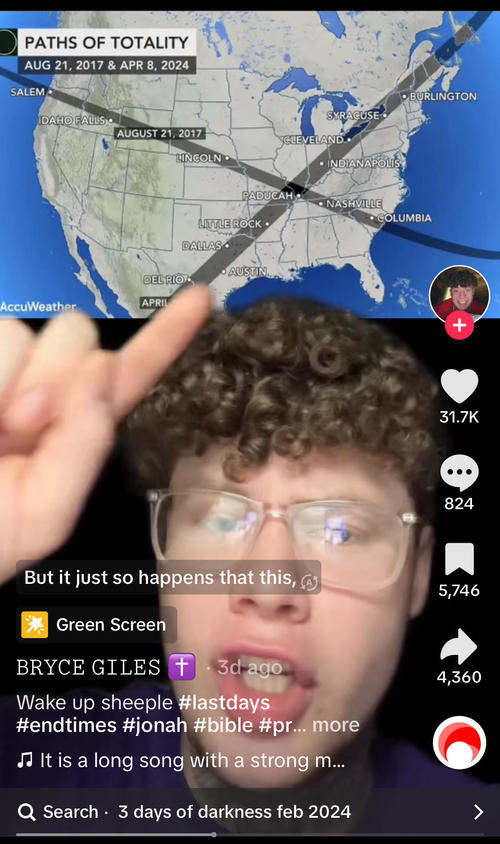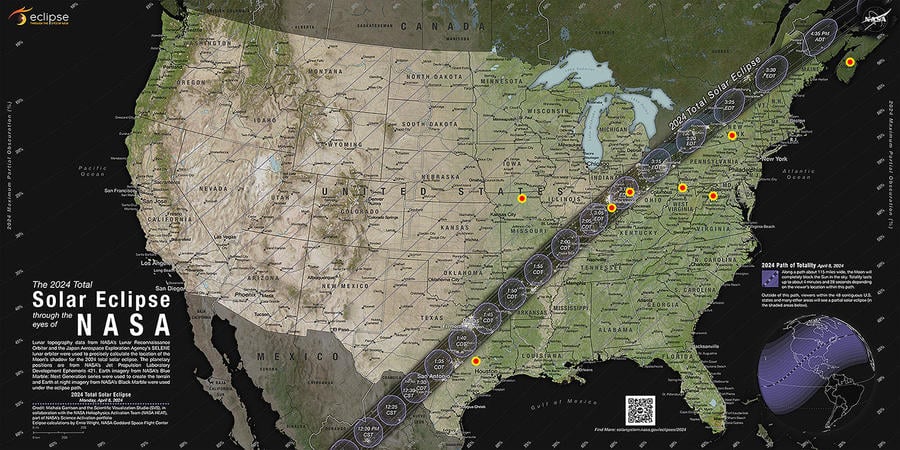
Will the April 8, 2024, solar eclipse entirely obscure the sun for eight North American towns named Nineveh, as claimed in a video on TikTok? No, that's not true: Only two of the eight places named Nineveh mentioned in the video -- Nineveh, Indiana, and Nineveh, Ohio -- will experience a total solar eclipse on April 8, 2024. The other six places called Nineveh listed in the video are located outside the projected 115-mile-wide path of the moon's shadow and will experience a partial solar eclipse like every other town in the contiguous United States.
The claim originated in a video (archived here) on TikTok by @brycejustchillen on February 27, 2024. It was captioned:
Wake up sheeple #lastdays #endtimes #jonah #bible #prophecy #bibleprophecy #solareclipse #2024 #eclipse #wakeup #jesusiscoming #judgment #fypシ #fyp #foryou #foryoupageofficiall #viralvideo #blowthisupforme #tribulation #christian #jesuschrist
This is what the post looked like on TikTok at the time of the writing of this fact check:
(Source: TikTok screenshot taken on Fri Mar 1 20:06:58 2024 UTC)
The theme of this video is an end-times prophecy that @brycejustchillen associates with Bible verses. The scope of this fact check does not extend to prophecy. It's focused solely on the geographical claim about the 2024 eclipse and the eight places named in the video that are called Nineveh.
At 56 seconds into the video, a map is displayed behind the narrator, who points to the paths of the 2017 solar eclipse and the 2024 solar eclipse. He claims that the paths of these two eclipses make an X on the map. He says:
But anyways, what I'm getting at -- This right here is the 2017 solar eclipse and this right here is the 2024 solar eclipse. That's the path it's going to be making, it's going to be making an X over the United States. 2017 was seven years ago and the next one is seven years later which is going to be here in a month. You all know how the number seven always pops up in the Bible. But it just so happens that this 2024 one is going to be going through some towns named Nineveh. Nineveh, Texas. Nineveh, Missouri. Nineveh, Indiana. Nineveh, Ohio. Nineveh, Pennsylvania. Nineveh, Virginia. Nineveh, New York. And Nineveh, Nova Scotia.
The image behind the narrator that lists the eight places called Nineveh has circulated independently, as seen in this February 10, 2024, Facebook post pictured below.
(Source: Facebook screenshot taken on Fri Mar 01 21:55:02 2024 UTC)
The image below, which will open larger in a new window, uses an eclipse 2024 map from NASA's Scientific Visualization Studio. Lead Stories has added dots to this map to highlight the locations of the places named Nineveh mentioned in the video on TikTok.
The NASA map has thin grey lines running parallel to the path of totality, defined by NASA as "where observers will see the Moon completely cover the Sun." These lines mark partial eclipse percentage measurements; each increment decreases by 5 percent as it moves away from the path of totality.
Only two places called Nineveh are inside the path of totality, Nineveh, Indiana, and Nineveh, Ohio. The remainder of the places called Nineveh will experience a partial eclipse with at least 85 percent or more coverage.
(Source: NASA's Scientific Visualization Studio Map with Lead Stories Nineveh place names pinboard overlay)
Only the largest U.S. cities are listed on the NASA eclipse map, and several of the places called Nineveh are little more than a crossroads in cornfields. An interactive map (here) can be enlarged to show very precise local detail of the Nineveh locations with eight numbered red pins and unnumbered blue pins indicating the approximate center of the 115-mile-wide path of totality.
An October 19, 2023, article on Space.com titled, "'99% totality' does not exist! Why you need to get to the path for April 8, 2024, total solar eclipse," explains that a partial eclipse is simply not comparable to the emotional impact of witnessing a total solar eclipse:
A lot of this comes with emotions that you just can't have at any other time. As it gets dark it's hard to shake a primeval feeling that the sun might not come back. However, it's that view of the solar corona -- the sun's wispy outer atmosphere -- that's the most precious sight. Does the sun really look like that? Seeing the sun as it really is for the first time -- a vast, spiky star in space -- is a profoundly beautiful and shocking sight.
In the Space.com article, Dr. Rick Fienberg, project manager, AAS Solar Eclipse Task Force at the American Astronomical Society, explains that a partial eclipse less than 75 percent may not even be noticed because our eyes adjust. In an interview about the April 8, 2024, eclipse with "The Sky This Month" YouTube channel, at 6:48 minutes in, Feinberg explains:
But there is no such thing as any percent total eclipse except a hundred. Even when the moon has 99% eclipsed as it will be very close to the path, a little bit north of Concord [New Hampshire] but not far enough North to be in the path of totality, it only is about as dark as an overcast day. It's still daylight. It's darker than a sunny day but it's still daylight, even at 99%.
Additional Lead Stories fact checks of claims about a solar eclipse can be found here.















